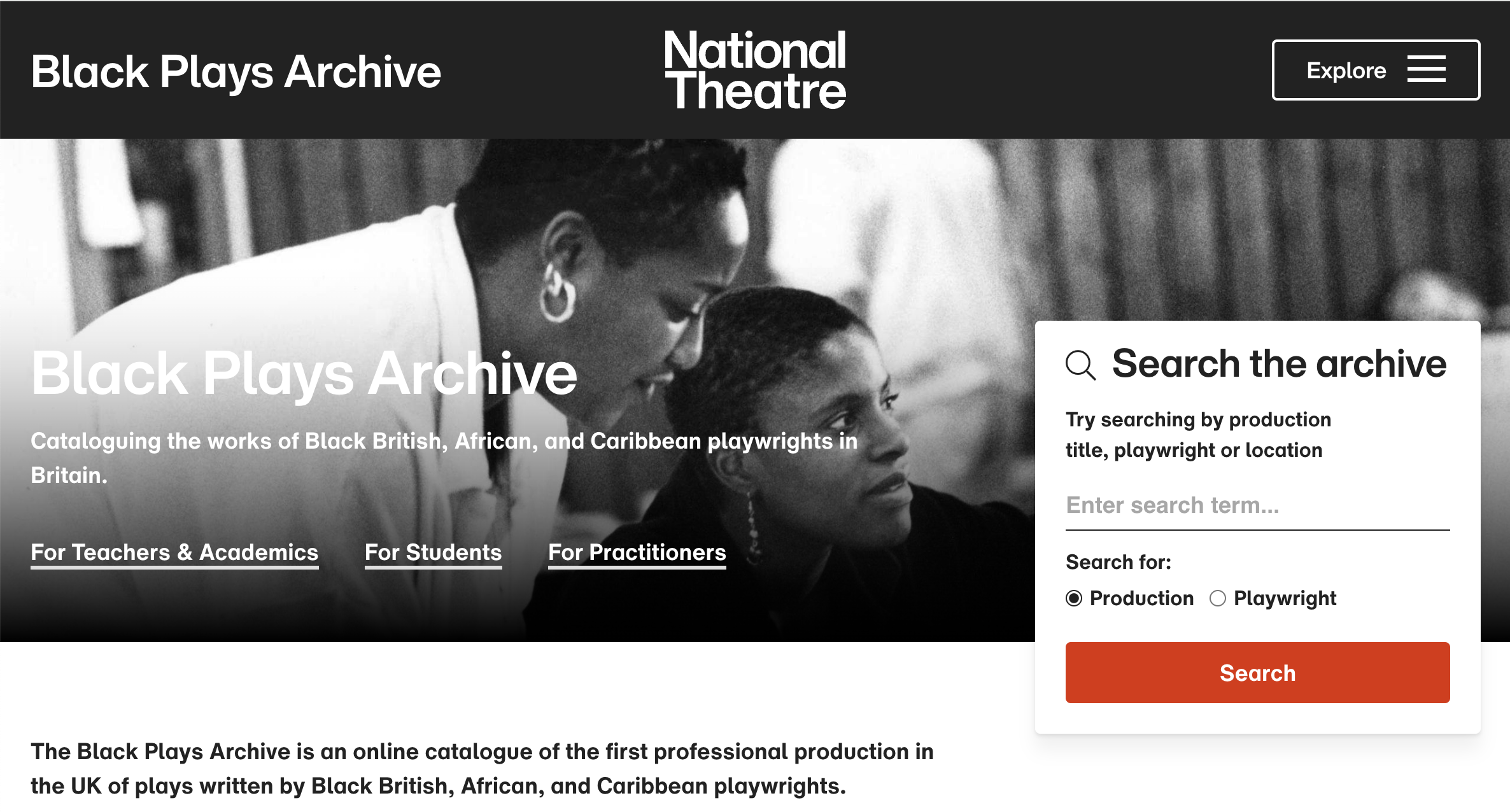Cataloguing Black voices in theatre
Excited to share my last product launch of 2023 – the new Black Plays Archive, which was a real joy to define, develop and deliver for the National Theatre in collaboration with the excellent team at Substrakt.
The Black Plays Archive is National Theatres’s online catalogue of the first professional production in the UK of plays written by Black British, African, and Caribbean playwrights. With over 900 plays and 300 playwrights from all over the UK, it's an incredible resource, but the dated UX of the old site was letting it down.
To mark its 10th anniversary, the NT were looking to refresh and rethink the online experience, and first and foremost to make it easy-to-use and accessible for audiences.
The homepage of the new Black Plays Archive makes it clear what it is, who it’s for and what users can do here
The job at hand
Our job was to define new and intuitive ways for users to search, browse and filter the catalogue, and discover curated collections of content.
The archive was powered by CALM, their cataloguing system set to stay put, which sorts records into ‘Productions’ and ‘People’.
The Black Plays Archive records had been updated manually, through a CSV upload, at regular intervals – and it continues to function this way, due to the relatively small number of new records added to the site.
This project had a modest budget assigned to it, and therefore, we had a more light-touch approach when it came to user research.
Problems to solve
As it often is, the need for the NT to update the Black Plays Archive was down to several factors:
The site was in a sore need of a re-platform – from an old version of Drupal, it needed to be brought onto Wordpress, which the organisation uses for the institutional website
In addition, the user experience was outdated, clunky, leading to a busy and overwhelming looking interface
This contributed to the site being inaccessible by screen-readers, and difficult to use for users with other visual impairments or cognitive needs
There were several search boxes, often not fully understood by the NT staff as to how they functioned
This contributed to the users not being able to find results they were looking for, or to fully understand the breadth and depth of the archive
No user research had underpinned how the existing site worked, and it was unclear who the end user was meant to be, or what their needs were
Rich content, such as stories or videos sat separate to the playwright and production records, making it difficult for users to discover records via the stories, and vice versa
The navigation and information architecture were confusing, lacking in clear purpose
Following on from the new website rethink of the National Theatre website, which you can read more about in this post, it was also key for the Archive to meet the brand, UX and accessibility standards of the NT’s overall digital estate
The method
The end-users
With each project, it’s important to start with what success looks like, with the key stakeholders.
For the new Black Plays Archive, this was best described by Erin Lee, Head of Archive at the National Theatre and the designated product owner of the BPA.
“The new Black Plays Archive is easy to navigate and accessible, users found the thing they were looking for, they discovered something interesting and new, they found more than they thought, and they are inspired to read and stage more plays by black authors.” – Erin Lee
Next – we defined our audiences.
In the absence of a user research budget, we had worked with archivists and people the staff knew about, from within the BPA community, who had previously used the archive to discover and search the archive.
Very quickly, we learned these neatly fell into 3 groups:
Teachers and academics – those looking for something specific, or within specific filters
Practitioners – for example playwrights, directors, producers, actors and other theatre-markers
Students – ranging from schools through to higher education
All of these users could be in different ‘modes’ when interacting with the Archive, ranging from seeking inspiration through to deep, specific searches.
It was decided from early on, that rich content would be clearly organised on landing pages for each of the user groups, to make it really easy for users belonging to that group to find useful resources.
For example, actors looking for monologues can now easily find Monologue Resources on the Practitioners page, and find useful links beyond the Archive itself.
This, coupled with a fairly simple mechanism of searching for something specific, or browsing productions or playwrights, meant that pages could be simplified to:
Homepage
About
Contact us
Search/ Browse + results page
The takeover menu reflects how to get to these destinations easily.
The takeover menu makes it easy to search, browse or access resources relevant to end users
Translating insights into scope
There were specific use cases that helped us understand what the new Black Plays Archive search and filter would need to entail.
For example, we learned that teachers often visited the Archive because they were looking for plays about certain topics.
It was also important to teachers to filter results by cast size to fit their classroom size.
We also learned that actors often used the archive to find monologues for their auditions, and so cast size needed to start from ‘1’ within this filter.
For all groups of users, it was important to search by year ranges – for example, ‘show all plays staged in the 1960s’, or all ‘show playwrights who have staged shows in 1995’.
Good search needs good data
Now that we understood the broad user needs, it was time to look at the data in CALM.
More specifically, we needed to understand which fields were complete, e.g. titles and playwrights, and which needed to be updated before the re-platform. Why?
Any search is only as good as the data that is fed into it.
We knew it was important for users to search by topics. While there was no tagging mechanism in the backend to organise plays and playwrights into ‘set’ themes, the minimum we needed to do was to ensure each playwright and play had a short description.
This meant we could then search those and surface them to users – if their search term matched one in the title, work or description.
Dates were a little tricky – not all playwrights had a date of birth or death, some were still alive, and others had dates missing altogether. This meant that searching by birth or death rate would be useless as a filter, as it would hide most results.
However, as an archive of professionally produced plays, it was important to ensure every play had a ‘date/ year first performed’ assigned to each record. This then allowed users to filter plays by year ranges – or decades.
This mechanism acted as an important discovery tool too – users can easily learn that all productions in the Archive date from 1900 up until now (or 2030 more specifically to mark the current decade).
‘Productions’ results can be filtered down to year ranges or decades, as well as cast size
Results
Launched just before Christmas 2023, the new Black Plays Archive is an exciting destination in its own right.
Actors, playwrights, directors, teachers and academics alike, can now easily find plays and playwrights dating from 1909 until today, filter results to a year range they're interested in, or filter by cast size – starting with monologues.
They can also easily find resources and useful curated content, according to their needs.
This project was my second collaboration with the National Theatre, after product leading on the main website (launched Jan 2023).
I continue to be delighted by the NT's openness, focus on the user, ability to prioritise – and embracing each project as a true collaboration.



